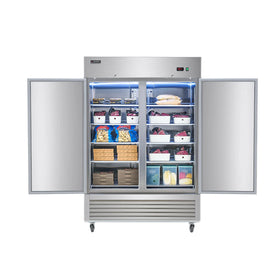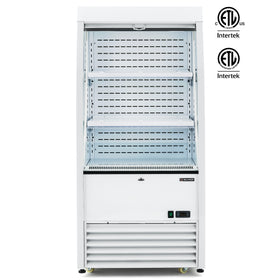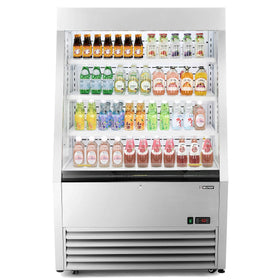The biggest barrier to starting a sandwich shop is usually the cost involved. However, if you acquire some firsthand experience in the business (before starting on your own) and formulate a good sandwich shop business plan, you won't need up to $50,000 to make it in the sandwich business.
We are breaking down the art of starting a sandwich shop on a budget, and we will also bring you the real-life advice people wish they had known before they started.
Here’s how to start a sandwich shop in 7 steps
1. Start by Volunteering or Working Part Time
Here is probably the most crucial piece of advice when starting a sandwich shop: volunteer or work part-time at an already successful sandwich shop for some months before you make any financial investment.
This firsthand experience is crucial because it will expose you to the daily realities of running a sandwich shop and will help you decide whether you really have the will, passion, and aptitude for starting a sandwich business.
Also, you will have a better understanding of the industry and know what works in the food market in general, and the sandwich market in particular.
2. Do Appropriate Market Research
The main purpose of market research when starting a sandwich shop is to help you identify your target market, figure out your brand identity, choose the right location, create the right menu, and set a reasonable pricing strategy. Here are some key elements of your market research:
i. Identify and understand your target market.
Your target market is the specific segment of the population that will constitute your primary customer base.
You could define them by profession (office workers, college students), by age (youths and young adults, university students), or by social factors (families, church groups, and other groups).
ii. Choose Your Niche
In business, a niche is like your area of specialty. In the case of a sandwich shop, your niche will be the specific types of sandwiches you excel at.
To be successful at choosing a niche, you need to be able to offer something different from (or better than) what your competitors are offering.
For a sandwich shop, your niche can be artisan sandwiches, healthy wraps, specialty melts, etc
- Gourmet grilled cheese with fun twists
- Classic subs and paninis
- Plant-based or gluten-free sandwiches
- International flavors—think banh mi, tortas, or kati rolls
- Soup & sandwich pairings for cozy lunch vibes
iii. Formulate a Good Business Plan
Write a plan covering your sandwich shop menu, marketing strategy, operations, and finances. A business plan is really important if you intend to secure funding from a bank or a financial institution.
- Even if you are starting a sandwich shop with no funds, you might still need a business plan if you intend to find a partner (we will get to partners).
Pro Tip
Write down a solid 3–5 year business plan. Write it down—not scribbles on napkins. You’ll need it to get loans, attract partners (if you must), and keep your goals clear.
iv. Make a Good Sandwich Shop Menu
Here are two tips for coming up with a sandwich shop menu: (1) keep it simple, and (2) don't be cheap. Find out what types of sandwiches are most desirable to your target market, and make sure those are always on the menu.
- You can add other sophisticated options, but make sure you introduce them gradually. Do not take out the popular options.
Also, don't be cheap.
Whatever you choose, don’t be the cheap sandwich shop. Competing with Subway on price is a losing game. Focus on being the sandwich shop that’s worth it—delicious, memorable, and made with love.
v. Pick the Right Location
The right location is key to the success of any business, but most especially a sandwich shop. Even a small space can work wonders with the right crowd.
- Look for an area that is accessible to your target customer group, but also has high foot traffic.
- The best locations for sandwich shops are areas near offices, schools, or neighborhoods.
3. Start Small, Build Later
When starting a sandwich shop, do not rush into heavy financial investments. Test out your concept on a much smaller scale to get a feel of the market and find out whether or not your concept is profitable, sustainable, and scalable.
Here’s how to start small when opening a sandwich shop:
- Try a food truck or trailer. It’s more affordable, flexible, and easier to run mostly on your own.
- Farmers' markets and festivals are fantastic ways to test your concept, build a following, and figure out what people love (or don’t).
- Pop-ups are powerful. If possible, partner with a local bar or café to run a pop-up kitchen? It’s a low-cost way to test the waters without signing a long lease or buying all your gear.
- Try to get a sandwich stand at a farmers' market. It's a great place to find your rhythm and your regulars, without the full commitment of a brick-and-mortar shop.
Starting small helps you stay nimble, build a customer base, and adjust your menu/processes without the pressure of a giant overhead.
4. How Much Does It Cost to Start a Sandwich Shop?
The cost of starting a sandwich shop can be about $50,000, but if you are willing to start with a food truck, pop-up, or rent a space somewhere that's already taken, $20,000 can work.
If you are willing to start with a food truck or small shop, for example, here is an estimate of how much you might need to start a sandwich shop:
| Expense | Estimated Cost |
| Truck/Trailer or Small Lease | $10,000 – $50,000 |
| Equipment (used when possible) | $5,000 – $25,000 |
| Permits & Licenses | $1,000 – $3,000 |
| Initial Food Inventory | $2,000 – $5,000 |
| Working Capital (3–6 months) | $10,000 – $30,000 |
| Contingency Fund | $5,000+ |
| Estimated Total | $25,000 – $100,000+ |
Look for turnkey locations—restaurants that closed and left the equipment behind. But do your homework; sometimes they failed for a reason (bad location, bad setup, etc.).
How to Get Funding: The Good, The Bad, and the Caution Tape
- Banks usually won’t lend without a proven income stream. Start small, and get some traction first, then you can show profit and apply for loans.
- Investors can be tricky. If you bring one on, read the fine print. Giving up control early can come back to haunt you. Don't do it unless you absolutely have no other option.
- Friends and family? Tread carefully. It's your dream, but money can complicate things.
5. Get The Right Sandwich Shop Insurance/Licences
For sandwich shop insurance, look into bundling policies with a Business Owner’s Policy (BOP)—it’s often cheaper and easier to manage. Depending on the laws in your state, you might need:
- General Liability – Covers accidents and injuries in the shop.
- Property Insurance – Covers equipment and inventory.
- Workers’ Compensation – Required if you hire staff.
- Business Interruption – Helps if you have to shut down temporarily.
- Food Spoilage Coverage – A lifesaver if the fridge dies overnight.
Know how to Manage Legal & Financial Tasks
There are a lot of legal/financial demands that go into starting a sandwich business. Sometimes, it is best to seek out a financial expert, but most times, diligently managing your finances and treating your employees well will keep you out of trouble.
Here are some tips to save you from going under.
- Form an LLC or S-Corp. Keep your business and personal finances separate.
- Hire a good accountant. They'll save you from tax nightmares.
- Sales tax and tips are NOT your money. Mismanage either and you could face serious penalties or worse.
- Don’t cheap out on payroll services. Paying employees late or wrong? Recipe for disaster.
6. Get the Right Sandwich Shop Equipment
You probably can find great used equipment everywhere, because restaurants, sadly, go under all the time. However, whether or not that will reduce your cost in the long run is up for debate.
What we counsel is to look for affordable commercial kitchen equipment that will serve you long term. And there are several reliable brands that supply those.
Here’s a list of sandwich shop equipment you will need, and some affordable options
i. Prep tables
You can always go for an individual prep table, but on a budget, go for a prep table refrigerator: a two-in-one in one equipment that offers a full-length cutting board and space for a refrigerator as well.
Commercial Salad Prep Table Refrigerator is a two-door refrigerated sandwich prep table that features a 15.3 cu. ft. volume, a full-length cutting board, and 16 GN 1/6 pans, offering ample space for smooth sandwich and salad preparation, as well as backup ingredient storage.
If you need more capacity or operate in a smaller space, here’s a collection of commercial prep table refrigerators you can choose from.
ii. Fridges and Coolers.
You cannot start a sandwich shop without commercial refrigerators- that goes without saying.
You need under-counter fridges, reach-in refrigerators, and display coolers for milk, syrups, food items, etc., and for frozen items, ice, or make-ahead baked goods.
iii. Sink stations
A sink station keeps the workspace clean, safe, and efficient. Separate sinks for handwashing, dishwashing, and food prep prevent cross-contamination.
Go for a sink station with designated sink areas to streamline cleanup and reduce bottlenecks during busy service times.
iv. POS system (Square or Toast is are good starter)
Get what you need, and add the nice-to-haves later.
7. Running the Shop: What It’s Really Like
- Prep is your lifeline—chop, stock, and clean before opening.
- You’ll wear every hat: cook, cashier, cleaner, social media manager, plumber.
- Health inspections aren’t a joke. Stay ahead of the code or get shut down.
- Find a good exterminator. No one wants to talk about this, but every restaurant has to.
- Customer feedback is gold. Adjust your menu/processes based on what you hear.
Oh, and you can’t clock out from ownership. Your business comes home with you. Every. Single. Day.
Sandwich Shop Tips from the Trenches
- Don’t give up equity early. It’s tempting, but it’s your dream—don’t share it with someone you’ll regret.
- Build slowly. If you succeed in small things, you’ll attract banks or the right kind of partners.
- Care about your people. Pay fair, treat right, and good employees will stick.
- Your sandwiches need to stand out. Great bread, bold flavors, consistency.
You Got This
It’s going to be hard. It’s going to be stressful. But it’s also worth it. You’ll feed people. You’ll create something real. You’ll give your community a place to eat, connect, and come back to. And that’s a beautiful thing.
You might also be interested in these 5 affordable commercial refrigerators and the top 5 commercial kitchen maintenance tips to keep your sandwich shop up and running.










